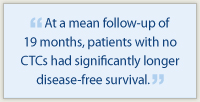According to the NCI, an estimated 49,260 new cases of oral cavity, pharyngeal, and laryngeal cancers occurred in the United States in 2010, and approximately 11,480 deaths were attributed to these cases. It is estimated that 95% or more of these cases are squamous cell carcinomas. Currently, the presence of lymphatic metastasis is the best predictor of prognosis in squamous cell carcinoma of the head and neck. There is a need for reliable serologic markers of prognosis, particularly markers that can identify patients at risk for locoregional or distant recurrence.
Novel Technique
In a recent article in Archives of Otolaryngology—Head & Neck Surgery, Jatana and colleagues, from The Ohio State University in Columbus, describe the performance of a novel technique for detecting and measuring circulating tumor cells (CTCs) to predict prognosis in patients with squamous cell carcinoma of the head and neck.1 Techniques for isolating and measuring CTCs have generally involved depleting blood samples of red blood cells and positively selecting CTCs for measurement by using an antiepithelial antibody bound to a magnetic particle. Positive selection methods may be prone to bias due to selection of only those circulating tumor cells bearing the surface markers for which the antibodies are specific.
Currently, the only FDA-cleared system for detecting CTCs in peripheral blood is the CellSearch system (Veridex LLC), which is used for detecting CTCs in patients with metastatic breast, prostate, and colorectal cancer. This system uses immunomagnetic labeling and automated digital microscopy to capture and count CTCs, with the CTCs being bound by monoclonal epithelial cell adhesion molecule antibodies.
Method and Criteria
 Jatana and colleagues developed a negative depletion method in which samples are enriched for CTCs by depletion of normal blood cells.2,3 In this technique, blood samples undergo red blood cell lysis followed by labeling using an anti-CD45 tetrameric antibody complex and dextran-coated magnetic nanoparticles; CD45 is expressed at high levels on the surface of all nucleated hematopoietic cells. The labeled cells are then passed through a magnetic deposition sorting system, resulting in depletion of peripheral blood leukocytes.
Jatana and colleagues developed a negative depletion method in which samples are enriched for CTCs by depletion of normal blood cells.2,3 In this technique, blood samples undergo red blood cell lysis followed by labeling using an anti-CD45 tetrameric antibody complex and dextran-coated magnetic nanoparticles; CD45 is expressed at high levels on the surface of all nucleated hematopoietic cells. The labeled cells are then passed through a magnetic deposition sorting system, resulting in depletion of peripheral blood leukocytes.
To test for the presence of circulating tumor cells, the enriched samples undergo cytospin for immunocytochemistry staining. Initial staining consists of incubation with a dilution of anticytokeratin fluorescien isothiocyanate conjugated (FITC) antibody CK3-6H5, which recognizes cytokeratins (8, 18, and 19) present on epithelial cells. Additional staining is performed with 4,6-diamidino-2-phenylindole (DAPI), which stains cell nuclei, with specimens then being analyzed by fluorescent microscopy.
The criteria for CTCs in the study were that cells had to be positive for both FITC and DAPI staining, have an intact membrane, and have a high nuclear to cytoplasmic ratio while being at least as large as surrounding peripheral blood leukocytes. Since CD45-positive cells were removed via magnetic sorting, it was assumed that all remaining cells in the sample were CD45-negative. The concentration of CTCs per milliliter of peripheral blood was calculated using the numbers of CTCs on the cytospin, with appropriate dilution factors applied during the depletion process.
Key Correlations
Initially, testing in 48 patients with squamous cell carcinoma of the head and neck showed that this technique resulted in mean total cell depletion of 5.32 log10 and mean nucleated cell depletion of 2.53 log10. At that time, a mean follow-up of 19 months, patients with no CTCs had significantly longer disease-free survival (P = .01). More recently, presented at ASCO with additional prospective follow-up of 50 patients, at a mean of 26.6 months, the trend has continued (P = .045). Of these 50 patients, 70% had CTCs present.4
There were no significant differences between patients with CTCs and those without CTCs with regard to age, gender, proportion with smoking history of at least 15 pack-years, proportion with at least moderate alcohol consumption, tumor site, proportion who had received adjuvant therapy, or mean nucleated or total cell log depletion. Of particular interest was the finding that the two groups also did not differ with regard to stage of disease or proportion with nodal involvement, suggesting that presence of CTCs may be an independent risk factor for poorer prognosis.
Further Analysis
Follow-up of this cohort of patients continues, and circulating tumor cells from these patients have been lysed to obtain RNA for further molecular analysis. Potential advantages of the negative enrichment system are that it can eliminate bias for certain types of cancer (eg, those that express the epithelial cell adhesion molecule) and allow analysis of multiple markers on individual samples of CTCs, including markers that are not typically associated with epithelial cells. ■
Disclosure: Dr. Jatana reported no potential conflicts of interest.
References
1. Jatana KR, Balasubramanian P, Lang JC: Significance of circulating tumor cells in patients with squamous cell carcinoma of the head and neck. Arch Otolaryngol Head Neck Surg 136:1274-1279, 2010.
2. Yang L, Lang JC, Balasubramanian P, et al: Optimization of an enrichment process for circulating tumor cells from the blood of head and neck cancer patients through depletion of normal cells. Biotechnol Bioeng 102:521-534, 2009.
3. Balasubramanian P, Yang L, Lang JC, et al: Confocal images of circulating tumor cells obtained using a methodology and technology that removes normal cells. Mol Pharm 6:1402-1408, 2009.
4. Jatana K, Balasubramanian P, Lang JC, et al: Correlation of circulating tumor cells in SCCHN patients to cancer reoccurence using a negative enrichment technology. 2011 ASCO Annual Meeting. Abstract 5511. Presented June 3, 2011.

